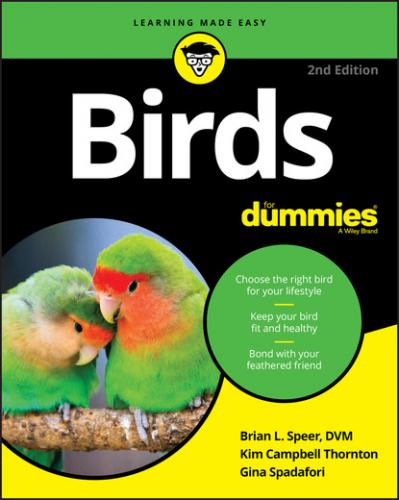How can you avoid such a scenario? Start by understanding what birds really are about and what they need, and determine what you can and can’t live with. Even a little knowledge can be good — and the more you know, the better!
Although we feature many varieties of companion birds in this chapter — including a few that the vast majority of bird lovers are best off avoiding — we offer a list of the ten best birds for beginners in Chapter 19.
Deciding What You’re Looking for in a Bird
If you can’t just fall in love with the look of a bird, what characteristics are worth considering? In the following sections, we describe the traits most people love or hate, so you can develop your own standards and compare them to the various species.
Judging interactivity
Bird species range in friendliness from the “don’t touch me” attitude of most finches to the Velcro-like manner of some cockatoos. That said, some finches can learn to interact with you and come to your hand, and cockatoos often probably shouldn’t be encouraged to live their lives attached to you — a little independence is a good thing.
Do you want a bird in the hand or one in the cage? Even within the highly intelligent and social parrot species, you can find differences in the amount of attention a bird wants — or demands, in some cases.
Are you comfortable being the center of another being’s life, or are you likely to find the demands for attention from such a bird to be tedious or entrapping after a while? The answer to this question can take you a step closer to one group of birds or another, and responding too casually to the question can lead both to your own unhappiness and your bird’s. So, give it some serious consideration.
Considering size
No matter how friendly they are, large birds scare some people. Their flapping wings and impressive beaks have only a distant appeal to the person whose idea of the perfect pet bird is a budgie who can balance easily on a single finger. Other folks love the dramatic presence the larger birds command.
You can find charming personality types in all sizes. If you like a social bird in a small package, parrotlets, lovebirds, and budgies can fill the bill. You don’t have to buy a big parrot to get a big personality!
Size counts for more than presence, however. Large birds require larger, more expensive cages. Plus, they go through food, toys, and perches more rapidly than their smaller counterparts and generally make a much larger mess. The initial price of a large bird is often greater, too.
Making a mess
Logically, larger birds make larger messes, but some birds really are over the top when it comes to covering every available surface with feces, feathers, and food. Top of the list: lories and lorikeets, lively and colorful nectar eaters with the ability to shoot their runny droppings some remarkable distances. This trait limits their pet appeal for many people, but some folks take these talents in stride, figuring the extra work is worth the companionship of these charmers.
A BRAVE-HEARTED PIGEON
Pigeon-hearted? It doesn’t mean what you think. G.I. Joe was a homing pigeon noted for his service in the United States Army Pigeon Service, used for communication and reconnaissance during World Wars I and II. Hatched in March 1943, he was presented with the Dickin Medal — the equivalent for animals of the Victoria Cross or Medal of Honor — for gallantry, awarded for “the most outstanding flight made by a United States Army homing pigeon in World War II.” His 20-mile flight, achieved in an impressive 20 minutes, saved the lives of more than 100 troops by delivering a message that prevented a friendly-fire event. After World War II, he was housed at the U.S. Army’s Churchill Loft at Fort Monmouth, New Jersey, and died at the age of 18 at the Detroit Zoological Gardens. In 2019, he was posthumously awarded the Animals in War & Peace Medal of Bravery.
Although lories and lorikeets may be the messiest, no bird can be considered truly neat. Well-designed cages, plenty of newspaper, a hand-vacuum, and a large assortment of cloth and paper towels can keep things under control, for the most part. Again, it’s all a matter of preference, tolerance, and mutual compatibility.
Bring in da noise
No bird is perfectly quiet. Finches keep up a constant chatter, and canaries have been encouraged through centuries of breeding to sing. Some birds, however, can make you yearn for the relative quiet of a house next to a major airport. Birds use their voices to communicate their feelings — of loneliness, of boredom, of isolation, or of just being alive. Some pet birds are noisy only at certain times, such as in the early morning or at dusk, while others can start up at any time.
You need to figure out your tolerance levels and balance them with the bird you’re considering. If peace and quiet is of paramount importance to you, no bird may fit into your life. Even the most patient souls may discover that the real screamers push their limits at one time or another.
Consider, too, your living situation — apartment, attached house, suburban dwelling, or acreage. The walls of an apartment building or attached house do little to muffle the sounds of the loudest birds, and that could lead to trouble with the neighbors — or even get you evicted. If you’re considering chickens or other backyard poultry as companions, keep in mind that zoning and homeowner’s association regulations may prevent the keeping of those birds. As an example, many cities have ordinances prohibiting the keeping of roosters or limiting the numbers of birds that a household can keep.
Talking ability
The ability
